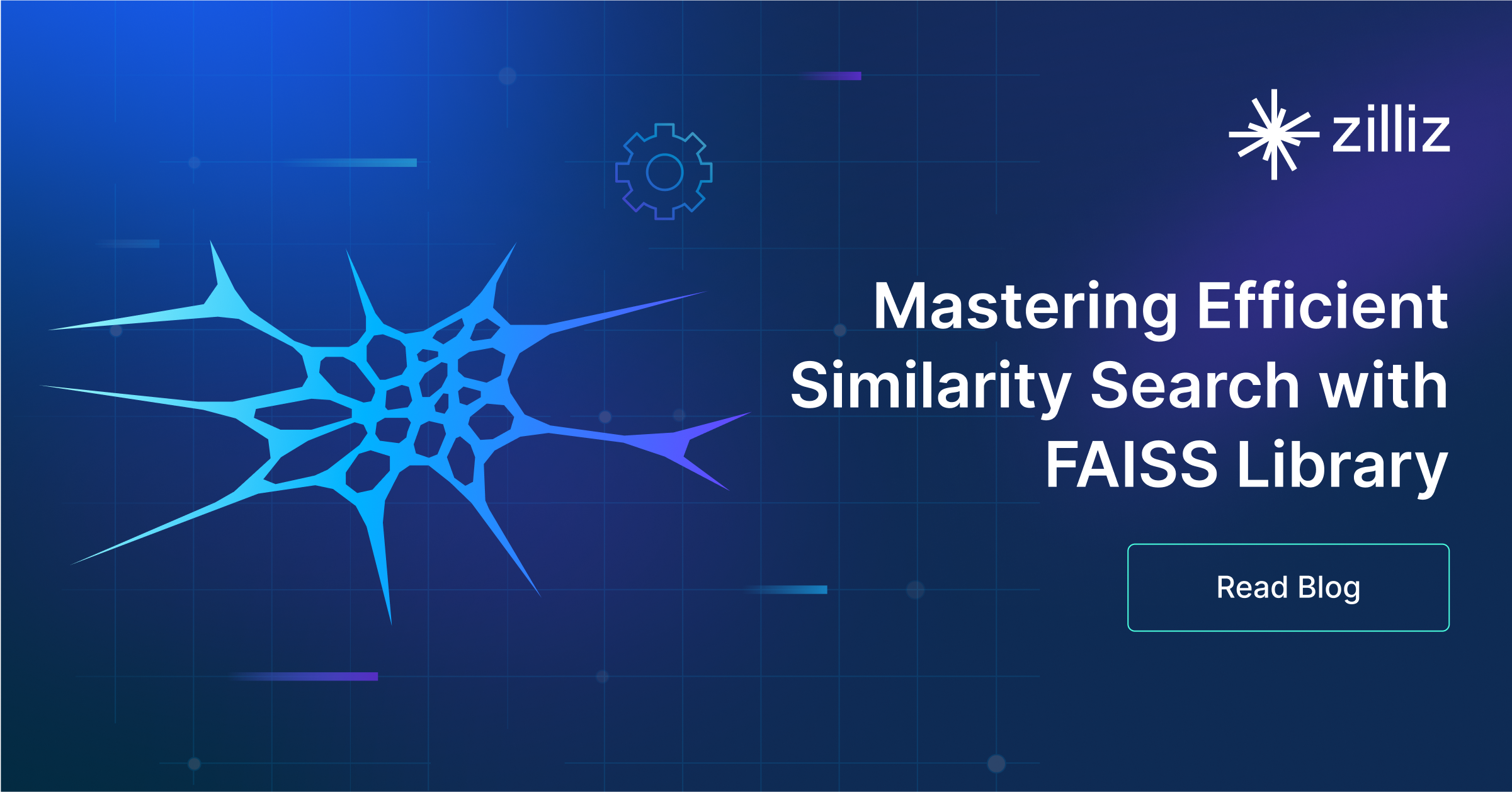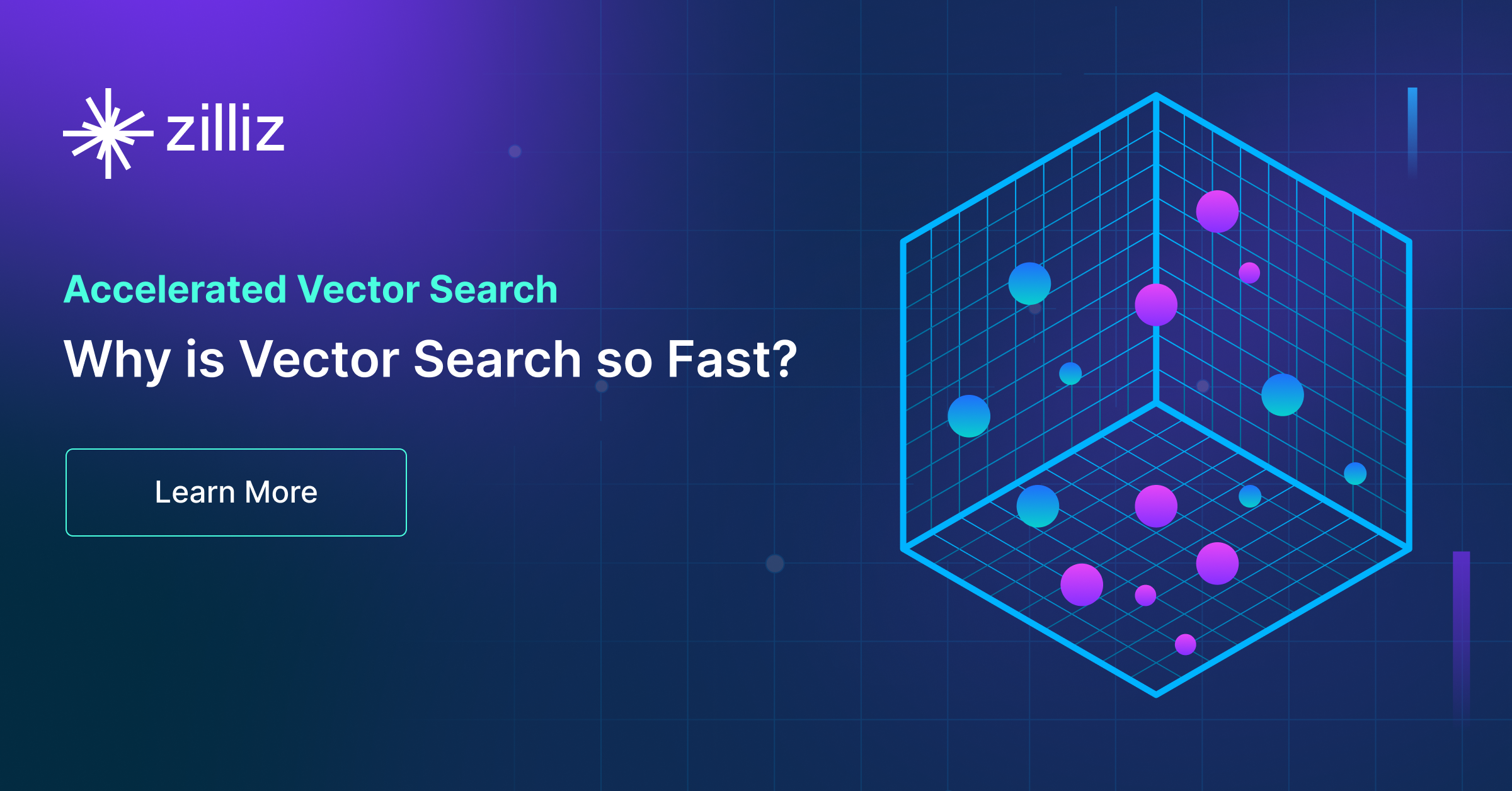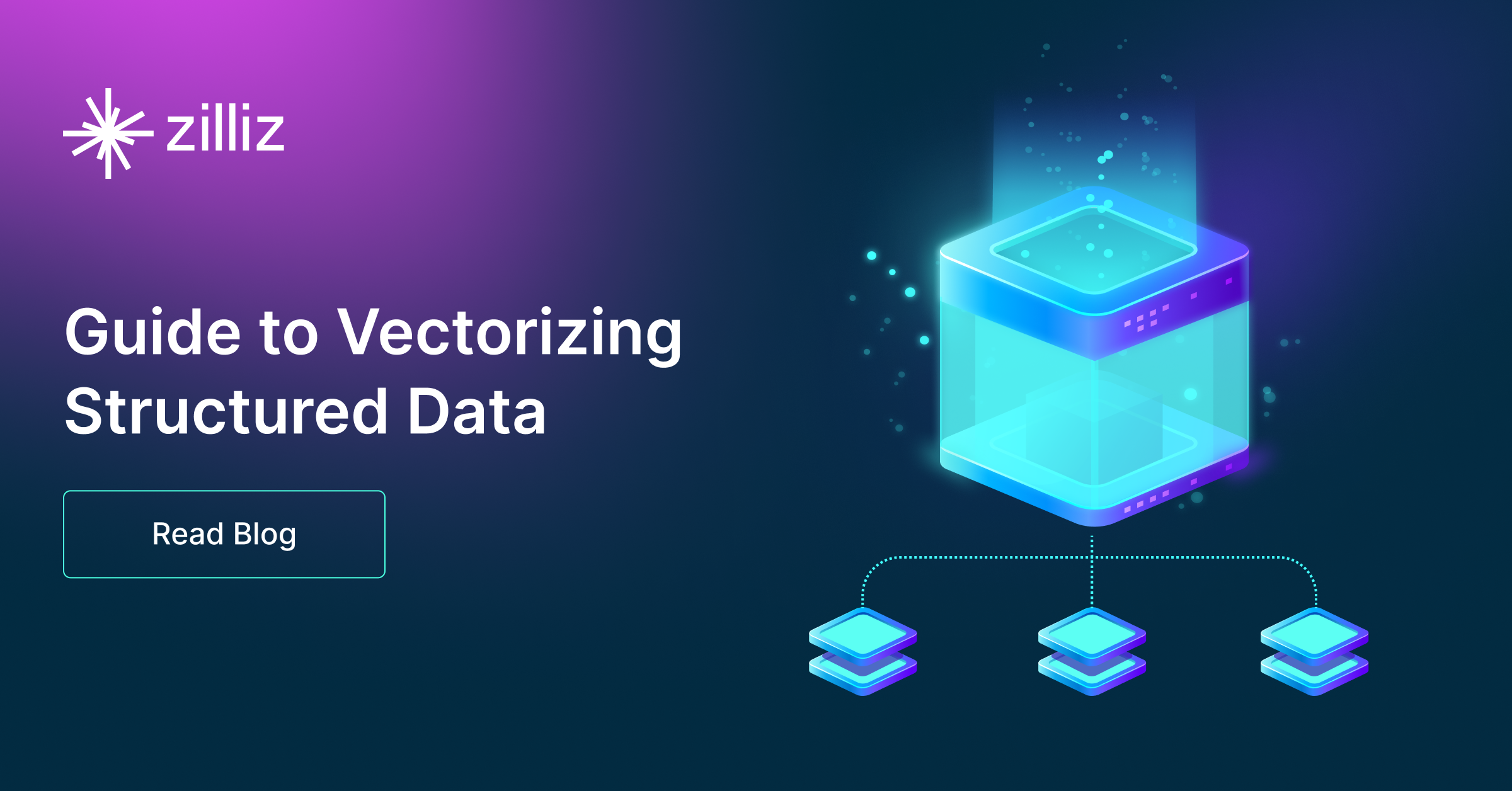Ranking Models: What Are They and When to Use Them?
Explore different ranking algorithms, their usage, and best practices. Uncover the real-world success stories of ranking algorithms and their evolution over time.
Read the entire series
- Raft or not? The Best Solution to Data Consistency in Cloud-native Databases
- Understanding Faiss (Facebook AI Similarity Search)
- Information Retrieval Metrics
- Advanced Querying Techniques in Vector Databases
- Popular Machine-learning Algorithms Behind Vector Searches
- Hybrid Search: Combining Text and Image for Enhanced Search Capabilities
- Ensuring High Availability of Vector Databases
- Ranking Models: What Are They and When to Use Them?
- Navigating the Nuances of Lexical and Semantic Search with Zilliz
- Enhancing Efficiency in Vector Searches with Binary Quantization and Milvus
- Model Providers: Open Source vs. Closed-Source
- Embedding and Querying Multilingual Languages with Milvus
- An Ultimate Guide to Vectorizing and Querying Structured Data
- Understanding HNSWlib: A Graph-based Library for Fast Approximate Nearest Neighbor Search
- What is ScaNN (Scalable Nearest Neighbors)?
- Getting Started with ScaNN
- Next-Gen Retrieval: How Cross-Encoders and Sparse Matrix Factorization Redefine k-NN Search
- What is Voyager?
- What is Annoy?
When you enter a query into a search bar, the browser presents you with relevant results. This is made possible by ranking models, which are powered by intricate algorithms and machine learning (ML). These models consider factors such as keyword relevance, document recency, and user behavior to list the most pertinent search results at the top of the page.
Before the advent of more sophisticated models, search algorithms relied on boolean logic to rank results based on user-defined conditions. While these models could sometimes produce overly specific or broad results, they were constrained in their adaptability.
Mitigating the challenges of boolean models, vector space models introduced the concept of relevance. These models identified relevant documents by calculating the similarity between search queries and document vectors. Probabilistic models went further by calculating the likelihood of a document being relevant to a user’s search query.
With ML, advanced search models revolutionized search rankings. Artificial intelligence (AI) driven search uses complex parameters like user intent, click-through rate, and user interactions to rank documents on the results page.
This article presents different ranking algorithms, their functionality, pitfalls, best-fit cases, and success stories.
Unraveling Ranking Models
Ranking models sift through an ocean of information to find the most relevant documents against a search query. This task is particularly challenging because modern databases contain billions of documents that must be scanned. Sophisticated techniques, like query analysis, similarity calculation, and relevance scoring, are crucial in identifying highly relevant results. Unlike earlier days, modern ranking models handle this vast amount of data, perform all these tasks in a significantly shorter time, and yield accurate results.
A typical ranking model goes through the following steps to find similar documents to the user search query:
- Query Analysis: The model analyzes a search query, extracts keywords, and understands user intent.
- Keyword Matching: The model then scans the database and identifies documents containing similar keywords.
- Feature Extraction: The model performs feature extraction in both the search query and documents, including content quality, keyword frequency, and other factors like user intent.
- Document Ranking: The model then applies a ranking algorithm on extracted features to measure the relevance of documents with the search query.
Ranking models have evolved from simple calculations to highly accurate models using machine learning and deep learning to find and rank documents according to user requirements. These models can be categorized into the following types:
1. Early Heuristic Models
These were basic models that relied on simple calculations and logic. Earlier popular algorithms like Boolean ranking and vector space models fall under this category. Their distinctive characteristics are:
- Use simple operators (AND, OR, NOT) or distance metrics to identify relevant documents.
- Yield overly specific results and struggle with complex queries.
Boolean models are suitable for small collections of documents where users can express their search intent in specific keywords. Meanwhile, vector space search models are still used along with neural networks in information retrieval systems, document clustering, and similarity analysis.
2. Probabilistic Models
These models estimate the likelihood of relevance of documents with the search query. The algorithm extracts different features from the input query and the database documents, including keyword frequency and the document's content, and uses these to calculate the relevance between the two.
Probabilistic models' distinctive characteristics include:
- Calculate probabilities to identify similar documents.
- Offers a nuanced identification of document relevance compared to earlier methods.
- Might be inaccurate at times and require massive amounts of training data.
Probabilistic models are still used in ML-based search algorithms, proving their relevance in the modern world. Universal search, document ranking, credibility scoring, and spam filtering are some of the common applications of probabilistic ranking models.
3. Machine Learning and Deep Learning Ranking Algorithms
Popular in the modern era, these models are trained on massive amounts of data to learn and improve their ranking ability. ML and DL models are implemented using two approaches, i.e., vector space model and learning to rank (LTR). Vector space models utilize embeddings and distance metrics to calculate the similarity between the query and the documents. LTRs are ML models that learn to predict the direct relevance of a query to the documents.
Modern deep-learning models are also context-aware, allowing them to handle ambiguous queries by analyzing surrounding terms. For example, if you search “Apple,” the model will analyze the surrounding terms to identify if you’re referring to the brand Apple or a fruit apple.
Distinctive characteristics of ML in search algorithms include:
- Provide highly accurate results and continue to improve.
- Consider features like user intent, impressions, and click-through rate.
- Use neural networks to understand the hidden context in a search query.
Machine learning and deep learning ranking algorithms offer boundless opportunities for user experience enhancement by constantly evolving and adapting to user needs and changing landscapes. Search engines, recommender systems, spam filters, and visual search are some of the applications of these algorithms.
Strategic Deployment: When and Where to Utilize Ranking Models
Ranking models are used in a variety of applications today. Whenever the display of relevant data based on a search query is needed, ranking models are good for executing this task. Let’s explore some of the common applications of ranking models.
Digital Libraries A digital library is a collection of documents or objects. During a search, the library sifts through the collection to find objects similar to those in the search query. Factors like search terms, user history and preference, and user intent help the ranking model identify similar objects in a digital library.
Online Marketplaces Ranking models are the heroes of the seamless experience online marketplaces provide. From product listing to recommendations and personalized homepages, ranking algorithms tailor results according to user preferences. Online marketplace ranking algorithms assess factors like keywords, user intent, purchase history, price, and listing quality to identify and fetch relevant products when a user searches for a query.
Personalized Content Feeds Like online marketplaces, news platforms, streaming applications, and social media personalize user feeds according to their preferences. Ranking models consider user history, search intent, and browser history to display the most relevant content on the user feed.
Search Engines Search engines rank web pages on the results page according to their relevance to the user query. User intent, keyword relevance and frequency, internal and external links, the popularity of a webpage, and domain authority play an important role in identifying similar results here. These factors help websites rank on search pages and build authority in their niche.
Selecting a Ranking Model
Picking the right ranking model depends on various factors. Adopting a ranking model before analyzing project needs and desired outcomes leads to inefficient ranking applications. Some of the important factors crucial to choosing the right model are:
Data Format Different ranking models suit different data formats. Simple models like probabilistic models work well with structured data, i.e., data with well-defined attributes. For unstructured and complex data like web pages or audio files, machine learning or deep learning ranking models are suitable.
User Engagement Metrics Applications that have explicit user engagement metrics available for analysis can use these metrics to personalize user experience. Explicit metrics are quantifiable measures that include user feedback data, clicks, ratings, downloads, time spent, etc. In applications where explicit metrics aren’t available, implicit metrics like user interaction and click-through rates impact the ranking results.
Computational Constraints Applications with large numbers of users, like search engines or social media sites, need models with faster processing times and accurate outputs. In applications where offline data analysis is suited, slower but complex ranking models do the job well.
While ranking algorithms enable users to search and rank relevant results, domain expertise is still needed to develop efficient models. Model transparency and fairness also play important roles in satisfactory user experience.
Implementing Ranking Models: Best Practices
There are three approaches to implementing ranking models: pointwise ranking, pairwise ranking, and listwise ranking. Whatever the approach, the implementation of ranking models undergoes a well-defined process. The implementation of ranking models within a search infrastructure involves the following steps:
Data Preparation Data preparation starts with gathering relevant data, such as user interaction and click-through rates. Once data is collected, the model scans it for errors like missing values, inconsistent values, or outliers. The data preparation stage involves detecting and correcting these errors.
Feature Extraction Once data is prepared, the model extracts useful features for further processing, i.e., keyword frequency, content type, and user interaction metrics. This stage sometimes also involves creating new features by manipulating the existing features, also known as feature engineering.
Model Selection and Training The next step is to choose an appropriate ranking algorithm based on the factors that affect model performance, including data format, user engagement metrics, and computational constraints. Once a model is selected, it is trained on preprocessed data to identify data patterns. The training stage enables a ranking algorithm to predict and yield relevant results against a user query.
Performance Evaluation After a model is trained on training data, it is evaluated to assess its performance on unseen data. Evaluation metrics like mean average precision (MAP), discounted cumulative gain (DCG), precision, and recall are used to measure the accuracy of a ranking model. The output of evaluation metrics guides model developers for model optimization by tweaking model parameters or even training another ranking algorithm.
Challenges of Implementing Ranking Models
Though the implementation process of ranking algorithms is straightforward, it might encounter some hurdles. When handled timely and effectively, these hurdles don’t affect model performance. However, ignoring them leads to irrelevant outcomes. Some common hurdles during the implementation of ranking algorithms include:
- Data Sparsity
New or niche ranking applications often have to deal with limited data. Limited data keeps models from identifying effective patterns during the training stage.
Solution: Data augmentation techniques can mitigate data sparsity challenges. These techniques involve creating synthetic data by manipulating existing training data. Using transfer learning, i.e., pre-trained models in a similar niche, helps achieve better model performance.
- Model Scalability
As a ranking application grows, its data and manipulation requirements also grow. Handling vast amounts of data and processing them to identify similar objects might be computationally expansive. Computational cost slows down the model's performance and might even affect its accuracy.
Solution: Using efficient model architectures or distributed computing frameworks improves the scalability of ranking models along with enhanced search precision.
- Interpretability
Deep learning models often have hidden underlying logic, making it difficult for users to interpret how ranking models rank similar objects and why one object ranks higher than the other. This raises concerns about fairness and makes model debugging challenging.
Solution: Implementing Explainable AI practices like Local Interpretable Model-Agnostic Explanations (LIME) to break down the model’s ranking logic enhances model interpretability. Using simpler models when possible, with inherent interpretability like probabilistic models, also helps maintain transparency.
Beyond these technical complications, domain expertise helps design suitable ranking algorithms based on niche requirements. Regular monitoring of ranking models to evaluate their adaptability and performance allows for addressing potential pitfalls.
Assessment and Enhancement of Ranking Models
User experience depends upon the performance of ranking models. For better user experience, optimal performance of ranking models is required. Several metrics and techniques are available to gauge the efficacy of ranking models. Here are a few of them:
- Precision@k
Precision is a metric that measures the relevance of search results to a user query. It measures how many of the retrieved results are actually relevant to the query. For example, precision@10 will analyze the top 10 results received and check how many are relevant to the query.
- Recall
Recall measures the number of all relevant documents or objects a ranking model retrieves from a database. For example, a recall of 0.8 indicates that a model retrieves 80% of the relevant documents. Hence, a value closer to 1 indicates a good model performance.
- Normalized Discounted Cumulative Gain (NDCG)
NDCG is a ranking metric that compares the ranking order of retrieved objects against an ideal order. For example, if a user searches for a movie, the model compares the movie search results against an ideal search result. The NDCG metric takes values between 0 to 1, 1 indicates an accurate match, and lower values indicate a less accurate match. These values help to tweak the model parameters to optimize model performance.
Metrics provide a good beginning for fine-tuning ranking models, but advanced techniques lead to comprehensive evaluation. A/B testing and evaluating against a diverse range of parameters are two of those factors that ensure fairness in model evaluation.
Once a model performance is measured, a typical next step is fine-tuning model performance. It takes multiple iterations to obtain an efficient model performance. Some of the key techniques for refining model performance are:
- Fine-tuning Parameters
Multiple hyperparameters shape the behavior of ranking models. Adjusting hyperparameters according to precision metrics enhances model performance. Techniques like grid search, random search, and Bayesian optimization are used for fine-tuning model parameters.
- Feature Engineering
Another way of refining model performance is to create new features by manipulating existing ones. This approach works when a certain combination of features enhances model performance or when specific features negatively affect model prediction. Tweaking such features leads to better performance.
- Ensemble Techniques
Ensemble techniques combine two or more ML models to utilize their powers. Instead of depending on one model, multiple models lead to better performance.
- Feedback Loops
A feedback loop is a process of comparing an AI-generated output with an external end-user action. An external end-user action might include user ratings or click-through rates to assess model understanding. This improves model performance over time by offering a human-like feedback cycle.
- Fostering Model Adaptability
Model adaptability is crucial to ensure a ranking model keeps up with the evolving search landscape. Techniques that allow ranking models to adapt to new user data and ranking practices are one way of ensuring model adaptability. Using active learning to choose the most important features also helps address outdated models.
Spotlight on Preeminent Ranking Models
Certain ranking models effectively identify similar objects in a database with ranking accuracy. From high accuracy to scalability and vast use cases, these models are used by established companies like Amazon, Google, and Netflix. These popularly used ranking models include Learning to rank algorithms, BERT-based rankers, and Neural ranking models.
- Learning to Rank (LTR) Algorithms
LTR algorithms aim for relevance scoring of a list of items against a user query. These models are trained on human-annotated or implicitly collected data. LTR can handle various data formats and usually uses stochastic gradient descent for model optimization. LTR algorithm has many best-fit use cases, some of which include:
- Search engines
- Recommender systems
- Information retrieval systems
Learning to Rank Success Story
Amazon uses an LTR algorithm to show the most relevant products to users when they enter a keyword in an Amazon search. The algorithm tracks keyword relevance, conversion rate, sales history, product images, impressions, availability, price, reviews, and click-through rate to rank the products on the search results page.
- BERT-based Rankers BERT stands for Bidirectional Encoder Representations from Transformers. BERT is a pre-trained transformer, a deep learning model that excels at understanding the context of natural language. BERT-based rankers capture finer details of a search query to yield more accurate results and go beyond keyword matching. Real-world applications of BERT-based rankers include:
- Search Engines
- Voice search
- Conversational interfaces
BERT-based Ranker Success Story
Google Assistant uses a BERT-based ranker to understand user queries and yield precise search results. BERT also highlights relevant sentences or passages of web pages in search results. Moreover, it allows Google Assistant to learn user pronunciation and conduct natural conversations.
- Neural Ranking Models Neural ranking models use neural networks to identify hidden patterns and learn connections between data points. These models can handle vast amounts of data, perform complex calculations, and offer scalability to adapt to changing needs. Real-world applications of neural ranking models include:
- Large-scale search engines
- Highly personalized recommender systems
Neural Ranking Models Success Story
Netflix uses a neural ranking model to provide personalized movie recommendations for users. The neural ranking model at Netflix considers user intent, preferences, watch time, watch history, and user profiles to generate recommendations. Netflix personalization also offers personalized messaging and engaging in-app notifications for users.
Choosing the right model depends on the application’s requirements. These include project goals and factors like computational constraints and data availability.
Navigating Future Horizons
Starting from the boolean search systems, ranking models have been through innovative transformations to date. The revolution hasn’t stopped yet, and ranking models are still evolving into more robust algorithms. These advancements offer boundless opportunities by keeping user experience and ethical considerations at the forefront. Emerging ranking models employ a range of techniques, which include:
Semantic Ranking Ranking models are surpassing the existing algorithms by using knowledge graphs for capturing relationships between a list of objects. Knowledge graphs make ranking models context-aware, leading to a human-like understanding of user queries and accurate ranking. Transformer architectures like BERT and GPT-3 allow ranking models to understand user intent at a deeper level as well.
User-Centric Personalization Using ML for context understanding allows businesses to offer users highly personalized systems. Employing XAI techniques is also important so users understand why a ranking model yields certain results. This enhances user trust in AI and leads to safer AI practices.
Advanced techniques like semantic search and user-centric approach enable the development of advanced ranking systems. With the rise of using natural language processing (NLP) in ranking systems, applications like voice and multilingual search are built on top of ranking models.
The rise of ranking models in various domains raises ethical concerns among users and the general public. Using unbiased and relevant data ensures ranking models don’t generate discriminating results. In addition, implementing XAI practices further enhances user trust, transparency, and clarity.
Data privacy policies that protect user data and use fair practices also play an important role in enhancing user trust, improving company reputation, and mitigating the risks of financial penalties.
Conclusion
Today, search engines rely not only on keyword frequency but also on user intent and behavior, which has revolutionized search ranking algorithms. Sophisticated AI techniques and ethical considerations promise a road to more advanced ranking algorithms that provide highly personalized ranking across various domains and languages.
Learn more about ranking algorithms and their implementation, including state-of-art ranking algorithms ListMLE and LambdaRank. Testing different ranking algorithms and participating in their implementation through side projects or open-source contributions will provide a diverse and valuable experience.
- Unraveling Ranking Models
- Strategic Deployment: When and Where to Utilize Ranking Models
- Selecting a Ranking Model
- Implementing Ranking Models: Best Practices
- Challenges of Implementing Ranking Models
- Assessment and Enhancement of Ranking Models
- Spotlight on Preeminent Ranking Models
- Navigating Future Horizons
- Conclusion
Content
Start Free, Scale Easily
Try the fully-managed vector database built for your GenAI applications.
Try Zilliz Cloud for FreeKeep Reading

Understanding Faiss (Facebook AI Similarity Search)
Faiss (Facebook AI similarity search) is an open-source library for efficient similarity search of unstructured data and clustering of dense vectors.

Popular Machine-learning Algorithms Behind Vector Searches
In this post, we’ll explore the essence of vector searches and some popular machine learning algorithms that power efficient vector search, such as K-Nearest Neighbors (ANN) and Approximate Nearest Neighbors (ANN).

An Ultimate Guide to Vectorizing and Querying Structured Data
This guide explains why and when you should vectorize your structured data and walks you through vectorizing and querying structured data with Milvus from start to finish.
